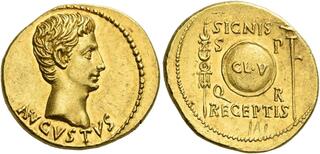This record is provided by CoinArchives, a database of numismatic auction catalogs.
Important copyright information:
The data below is presented by permission of the copyright holder(s). Reproduction is allowed only by authorization from Numismatica Ars Classica.
Important copyright information:
The data below is presented by permission of the copyright holder(s). Reproduction is allowed only by authorization from Numismatica Ars Classica.
| Numismatica Ars Classica > Auction 127 | Auction date: 17 November 2021 |
| Lot number: 300 | |
| Lot description: Octavian as Augustus, 27 BC – 14 AD Aureus, Caesaraugusta (?) circa 19-18 BC, AV 7.77 g. AVGVSTVS Bare head r. Rev. SIGNIS / RECEPTIS Aquila on r. and standard on r. flanking S – P / Q – R arranged around shield inscribed CL V. C –. Bahrfeldt –. BMC –. RIC –. CBN –. Calicó 274a (this coin). Apparently unique. A portrait of exquisite style, the work of a very talented master engraver, struck in high relief on a full flan. A very interesting graffito (owner's mark) on reverse, otherwise virtually as struck and almost Fdc Ex Harlan J. Berk Buy or Bid 81, 1994, 13 and Triton XI, 2008, 761 sales (miscatalogued as RIC 85a and attributed to the mint of Emerita). Graded Ch AU Strike 5/5 Surface 3/5 owners mark, NCG certification number 6157261-001 In the second half of the first century BC, Rome had suffered repeated shame at the hands of its powerful eastern rival, the Parthian Empire. In 53 BC, the wealthy M. Licinius Crassus, who dreamed of being a Roman Alexander the Great, was killed and his army shattered at Carrhae, thereby permitting the Parthians to capture the standards of the broken legions. A little more than a decade later, in 40 BC, at the instigation of the rogue Roman commander T. Labienus, the Parthians mounted a full-scale invasion of the province of Syria. This massive assault overwhelmed the governor and brought new standards into Parthian hands as trophies. Seeking revenge for these disasters and desirous of guaranteeing the stability of the buffer kingdom of Armenia, in 36 BC Marc Antony mounted a new campaign against the Parthians, but this too ended in disaster and the loss of further standards. At last, in 20 BC, the ascendency of Roman power in Armenia placed Augustus in a strong bargaining position with Parthia and he used it to reclaim the lost standards through diplomatic means. This was a major public relations coup for Augustus whose propaganda tended to focus on settling the upheavals of the preceding period of the Roman civil wars and looking forward to a glorious future with himself at the head of the state. The standards were brought back to Rome where a new temple of Mars Ultor (“the Avenger”) was vowed to house them. Initially the Senate had wished to erect this temple on the Capitoline Hill, but Augustus insisted that the temple should be built in his new forum so that all of the glory for the achievement—which tended to be given an inappropriate military sheen—should fall upon the emperor alone. This focusing of the glory on Augustus is indicated by the reverse type of this apparently unique aureus struck to commemorate the return of the standards. The latter, represented by a legionary aquila (eagle) and signum is shown flanking a circular shield. The inscription CL. V. makes it clear that this is no ordinary shield, but rather the clipeus virtutis—an honorific shield awarded by the Senate to Octavian in 27 BC when it recognised his leadership as Augustus, the first Roman Emperor. This aureus was miscatalogued in Triton XI as an issue of Emerita (RIC 85a, BMCRE 416 = BMCRR Rome 4396; CBN 1130). The coin is, instead, apparently unique and previously published only in Calicó. The cataloguer of the Triton sale did not realise that on the obverse of this specimen, the legend omits the title CAESAR, leaving only AVGVSTVS beneath the head. Furthermore, the portrait style is clearly different from those of Emerita. Following the arguments of Prideaux, the coin in the Triton XI was attributed to Emerita, while RIC tentatively assigned the issues with similar reverse types to Colonia Patricia. In our opinion instead, the style of the portrait leads us to believe that it is a product of the mint of Colonia Caesaraugusta. Furthermore, besides the legend and the portrait style, the aureus could not to be catalogued as RIC 85a, reference used in Triton XI, because in that issue the clipeus virtutis is flanked by an aquila on the left and a standard on the right, while here the standard is on the left and the aquila on the right. View a video of this lot Estimate: 60000 CHF |  |


